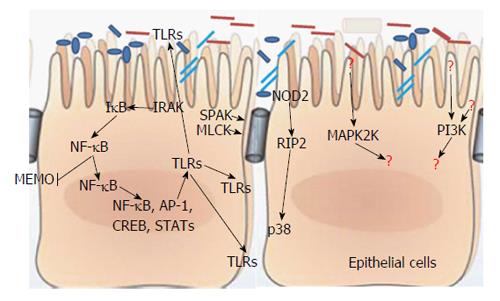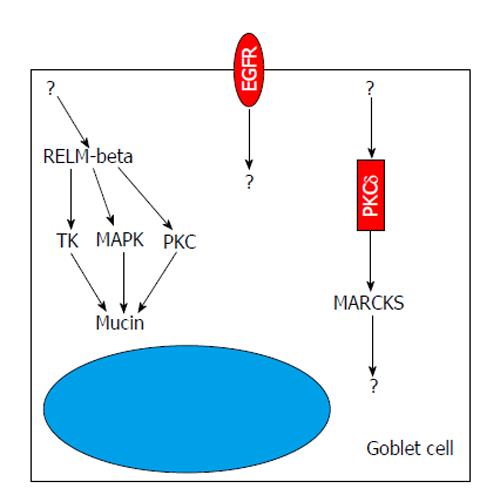Copyright
©2014 Baishideng Publishing Group Inc.
World J Gastrointest Pharmacol Ther. Nov 6, 2014; 5(4): 209-217
Published online Nov 6, 2014. doi: 10.4292/wjgpt.v5.i4.209
Published online Nov 6, 2014. doi: 10.4292/wjgpt.v5.i4.209
Figure 1 Intestinal epithelial cells use a variety of different molecules including protein kinases to monitor the presence of microbial pathogens, commensal bacteria, or host-generated products.
Pathogen-recognition receptors, including TLRs, NOD2, and NLRs, are located on and within the cell where they recognize different threats. Recognition results in NF-κB activation, leading to the production of cytoprotective factors when stimulated by commensal bacteria and proinflammatory products when stimulated by potential pathogens, or blocks the activity of NEMO. Some other undefined factors can stimulate protein kinases such as PI3K or MAPK2K to regulate the process of intestinal inflammation. TLR: Toll like receptor; IRAK: Interleukin 1 receptor associated kinase; IκB: Inhibitor kappa B; NF-κB: Nuclear factor kappa B; SPAK: Ste20 like proline/alanine rich kinase; NEMO: NF-kappa-B essential modulator; MLCK: Myosin light chain kinase; CREB: cAMP response element binding protein; STAT: Signal transducer and activator of transcription; NOD2: Nucleotide-binding oligomerization domain-containing protein 2; NLRs: NOD-like receptors; RIP2: Receptor-interacting protein kinase 2; PI3K: Phosphoinositide 3 kinase; MAPK2K: Mitogen-activated protein kinases 2 kinase; AP-1: Activator protein 1.
Figure 2 Intestinal Goblet cells employ different mechanisms including protein kinase related pathways to modulate the secretion of mucus, such as pathways related to tyrosine kinase, protein kinase C delta, myristoylated alanine-rich C-kinase substrate or receptors with tyrosine kinase activity such as epidermal growth factor receptor.
MARCKS: Myristoylated alanine-rich C-kinase substrate; EGFR: Epidermal growth factor receptor; TK: tyrosine kinase; RELM-beta: Resistin-like molecule beta; PKCδ: Protein kinase C delta; MAPK: Mitogen activated protein kinase.
- Citation: Yang L, Yan Y. Protein kinases are potential targets to treat inflammatory bowel disease. World J Gastrointest Pharmacol Ther 2014; 5(4): 209-217
- URL: https://www.wjgnet.com/2150-5349/full/v5/i4/209.htm
- DOI: https://dx.doi.org/10.4292/wjgpt.v5.i4.209










